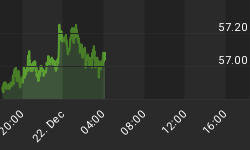An exercise I find quite useful to perform at the beginning of each year involves putting together an executive summary of the prognostications found in my Member Letter. In this fashion, any major discrepancies in the big picture outlook can be identified and addressed. The methodology discussed in the Member Letter involves cycle analysis, primarily for the dollar, stocks, gold, and the CRB. The outlook for each of these asset classes is outlined below.
The U.S. Dollar in Decline
More so than the last few years, I believe 2012 and even 2013 will be dominated by the behavior of the U.S. Dollar. A currency war is underway... a race to devalue... and I have little doubt the United States will "win" this war. As anticipated in the 2011 Outlook, the dollar formed a major low last spring, though the low was not quite immersed in the sense of crisis I expected. That crisis, I believe, will arrive with the next 3-year cycle low in the autumn of 2014.
In fact, the rally out of the 2011 low may be exhausting itself as I type. Public sentiment for the dollar is running very hot, and dollar cycles are behaving exactly as would be expected in the vicinity of a major trend change. Furthermore, as I will discuss below, commodities just left behind a major cyclical low in December, lending credence to the presence of a turning point for the dollar.
Given the macroeconomic backdrop in Europe, almost no one believes the dollar can fall. Therefore, once a trend change becomes obvious, everyone will be rushing for the exit simultaneously. The key level to watch during the decline is, of course, the 3-year cycle low from May 2011. Once that level is breached, we will have a failed cycle on our hands and should see generally lower prices for the buck until the next major cycle low in 2014.
Commodities - An Inflationary Storm Has Arrived
As mentioned above, commodities left behind a multi-year cycle low in December. From the April peak, the CRB dropped approximately 20%, retracing less than half of its 85% gain out of the 2009 low. With the dollar potentially seeing an early peak to its current multi-year cycle, I expect commodities to post, over the next two years, gains that dwarf the move out of the 2009 low.
Crude oil, in particular, should see huge gains. The black stuff has displayed strong relative strength by finding its own correctional low more than two months ahead of the general commodity complex and mostly resisting the final stages of the decline into the December low. Overall, gains in most commodities will be hefty enough to put severe pressure on already-damaged economies, leading to more bouts with social unrest around the globe.
Stocks - The World's Largest Roller Coaster
During the early stages of the inflation play, stocks should benefit along with commodities from the liquidity play. However, at some point in the next two years, the pressure from higher resource prices will touch off a tipping point, pressuring stocks lower, despite a falling dollar. At that point, dollar weakness itself will become a major point of concern, dragging stocks down in commiseration rather than driving them up.
As for 2011, stocks should rally during the first quarter as the initial leg of the dollar's drop unfolds. Equities are then due for a significant cyclical low in late April or early May. Their path out of that low is unclear and will depend highly on the extent of the damage done to our currency by that time.
Gold Rules
Along with the general commodity complex, I anticipate precious metals to enjoy further gains over the coming year and into 2014. Since both gold and silver formed parabolic moves in 2011, I would not expect their rallies to be as fervent as the recent past until those parabolic moves are consolidated. Over the course of their 11-year bull, precious metals have typically required 12-18 months to consolidate large moves and then revist highs. Therefore, I do anticipate gold and silver to at least test their 2011 highs, if not break through later in the year.
The path each asset takes on its way to its destination will no doubt be volatile. Emotions continue to run high regarding the state of economic management... or interference... in Europe and America, and the efforts by politicians and central banks to print their ways out of trouble will inevitably produce greater distortions. However, cycle analysis has, for the most part, enabled me to step on the gas during bullish phases and avoid or even short bearish phases. Like an economy, analysis is dynamic, and the outlooks above will be refined and traded accordingly as market action progresses.















